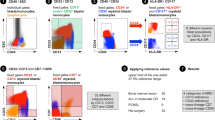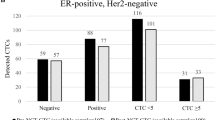Abstract
Identification of sensitive techniques for breast cancer cell detection might be relevant for high-dose chemotherapy programs with autologous stem cell transplantation. We investigated the feasibility of Maspin, Mammaglobin and c-ErbB-2 amplification by real-time quantitative polymerase chain reaction (RQ-PCR) for the detection of breast cancer cells in leukaphereses. Expression of the three markers was determined in primary breast cancers and cell lines. Peripheral blood (PB), bone marrow (BM), and leukapheresis samples from patients with malignancies other than breast cancer were used as controls. Sensitivity was evaluated by dilution of primary tumors and cell lines with mononuclear blood cells. We found expression of the three markers in all primary tumors and most cell lines. No blood specimen from control patients had the Maspin transcript, while only one was positive for Mammaglobin. Weak c-ErbB-2 expression was detectable in most PB, all BM and all leukapheresis samples from controls. We observed a low sensitivity of Maspin RQ-PCR and a sensitivity of Mammaglobin RQ-PCR up to one tumor cell in 106 mononuclear cells. One out of 18 leukaphereses from breast cancer patients screened for the presence of Mammaglobin mRNA was positive. We conclude that Mammaglobin RQ-PCR might be a useful tool for detection of leukapheresis contamination. Bone Marrow Transplantation (2001) 27, 517–523.
This is a preview of subscription content, access via your institution
Access options
Subscribe to this journal
Receive 12 print issues and online access
$259.00 per year
only $21.58 per issue
Buy this article
- Purchase on Springer Link
- Instant access to full article PDF
Prices may be subject to local taxes which are calculated during checkout




Similar content being viewed by others
References
Stadtmauer EA, O'Neill A, Goldstein LJ et al. Conventional-dose chemotherapy compared with high-dose chemotherapy plus autologous hematopoietic stem-cell transplantation for metastatic breast cancer New Engl J Med 2000 342: 1069–1076
Rodenhuis S, Bontenbal M, Beex LVAM et al. Randomized phase III study of high-dose chemotherapy with cyclophosphamide, thiotepa and carboplatin in operable breast cancer with 4 or more axillary lymph nodes Proc ASCO 2000 19: (Abstr. 286)
Fields KK, Elfebein GJ, Trudeau WL et al. Clinical significance of bone marrow metastases as detected using the polymerase chain reaction in patients with breast cancer undergoing high-dose chemotherapy and autologous bone marrow transplantation J Clin Oncol 1996 14: 1868–1876
Weaver CH, Moss T, Schwartzberg LS et al. High-dose chemotherapy in patients with breast cancer: evaluation of infusing peripheral blood stem cells containing occult tumor cells Bone Marrow Transplant 1998 21: 1117–1124
Pedrazzoli P, Battaglia M, Da Prada GA et al. Role of tumor cells contaminating the graft in breast cancer recurrence after high-dose chemotherapy Bone Marrow Transplant 1997 20: 167–169
Cooper BW, Moss TJ, Ross AA et al. Occult tumor contamination of hematopoietic stem-cell products does not affect clinical outcome of autologous transplantation in patient with metastatic breast cancer J Clin Oncol 1998 16: 3509–3517
Berois N, Varangot M, Osinaga E et al. Detection of rare human breast cancer cells. Comparison of an immunomagnetic separation method with immunocytochemistry and RT-PCR Anticancer Res 1997 17: 2639–2646
Braun S, Pantel K, Muller P et al. Cytokeratin-positive cells in the bone marrow and survival of patients with stage I, II, or III breast cancer New Engl J Med 2000 342: 525–533
Gerhard M, Juhl H, Kalthoff H et al. Specific detection of carcinoembryonic antigen-expressing tumor cells in bone marrow aspirates by polymerase chain reaction J Clin Oncol 1994 12: 725–729
Datta YH, Adams PT, Drobyski WR et al. Sensitive detection of occult breast cancer by the RT-PCR J Clin Oncol 1994 12: 475–482
Kruger W, Krzizanowski C, Holweg M et al. Reverse transcriptase/polymerase chain reaction detection of cytokeratin 19 mRNA in bone marrow and blood of breast cancer patients J Cancer Res Clin Oncol 1996 122: 679–686
Lopez-Guerrero JA, Bolufer-Gilabert P, Sanz-Alonso M et al. Minimal illegitimate levels of cytocheratin K19 expression in mononucleated blood cells detected by RT-PCR method Clin Chim Acta 1997 263: 105–116
Zippelius A, Kufer P, Honold MW et al. Limitations of reverse-transcriptase polymerase chain reaction analyses for detection of micrometastatic epithelial cancer cells in bone marrow J Clin Oncol 1997 15: 2701–2708
Zou Z, Anisowicz A, Hendrix MJ et al. Maspin, a serpin with tumor-suppressing activity in human mammary epithelial cells Science 1994 263: 526–529
Watson MA, Fleming TP . Mammaglobin, a mammary specific member of the uteroglobin gene family, is overexpressed in human breast cancer Cancer Res 1996 56: 860–865
Slamon DJ, Clark GM, Wong SG et al. Studies of the HER-2/neu proto-oncogene in human breast and ovarian cancer Science 1989 244: 707–712
Luppi M, Morselli M, Bandieri E et al. Sensitive detection of circulating breast cancer cells by RT-PCR of maspin gene Ann Oncol 1996 7: 619–624
Sabbatini R, Federico M, Morselli M et al. Detection of circulating tumor cells by reverse transcriptase polymerase chain reaction of maspin in patients with breast cancer undergoing conventional-dose chemotherapy J Clin Oncol 2000 18: 1914–1920
Min CJ, Tafra L, Verbanac KN . Identification of superior markers for PCR detection of breast cancer metastases in sentinel lymph nodes Cancer Res 1998 58: 4581–4584
Zach O, Kasparu H, Krieger O et al. Detection of circulating mammary carcinoma cells in the peripheral blood of breast cancer patients via a nested RT-PCR assay for mammaglobin mRNA J Clin Oncol 1999 17: 2015–2019
Wasserman L, Dreilinger A, Easter D et al. A seminested RT-PCR assay for HER2/neu: initial validation of a new methods for the detection of disseminated breast cancer cells Mol Diagn 1999 4: 21–28
Slade MJ, Smith BM, Sinnett HD et al. Quantitative PCR for the detection of micrometastases in patients with breast cancer J Clin Oncol 1999 17: 870–879
Heid CA, Stevens J, Livak KJ et al. Real time quantitative PCR Genome Res 1996 6: 986–994
Marcucci G, Livak KJ, Strout MP et al. Detection of minimal residual disease in patients with AML1/ETO-associated acute myeloid leukemia using a novel quantitative reverse transcription polymerase chain reaction assay Leukemia 1998 12: 1482–1489
Mensink E, van de Locht A, Schattenberg A et al. Quantitation of minimal residual disease in Philadelphia chromosome positive chronic myeloid leukaemia patients using real-time quantitative RT-PCR Br J Haematol 1998 102: 768–774
Pongers-Willemse MJ, Verhagen OJHM, Tibbe GJM et al. Real-time quantitative PCR for the detection of minimal residual disease in acute lymphoblastic leukemia using junctional region specific TaqMan probes Leukemia 1998 12: 2006–2014
Acknowledgements
This work was supported by grants from Associazione Italiana per la Ricerca sul Cancro (AIRC, Milan, Italy), from the Ministero dell'Università e la Ricerca Scientifica e Tecnologica (MURST) (to FL, EP, WP and MA), and from Compagnia di S Paolo. GC is a recipient of the ‘G Ghirotti Foundation, sezione Piemonte’ grant.
Author information
Authors and Affiliations
Rights and permissions
About this article
Cite this article
Leone, F., Perissinotto, E., Viale, A. et al. Detection of breast cancer cell contamination in leukapheresis product by real-time quantitative polymerase chain reaction. Bone Marrow Transplant 27, 517–523 (2001). https://doi.org/10.1038/sj.bmt.1702815
Received:
Accepted:
Published:
Issue Date:
DOI: https://doi.org/10.1038/sj.bmt.1702815
Keywords
This article is cited by
-
Role of maspin in cancer
Clinical and Translational Medicine (2013)
-
Real-time RT–PCR detection of disseminated tumour cells in bone marrow has superior prognostic significance in comparison with circulating tumour cells in patients with breast cancer
British Journal of Cancer (2006)
-
Real-time RT–PCR correlates with immunocytochemistry for the detection of disseminated epithelial cells in bone marrow aspirates of patients with breast cancer
British Journal of Cancer (2004)



